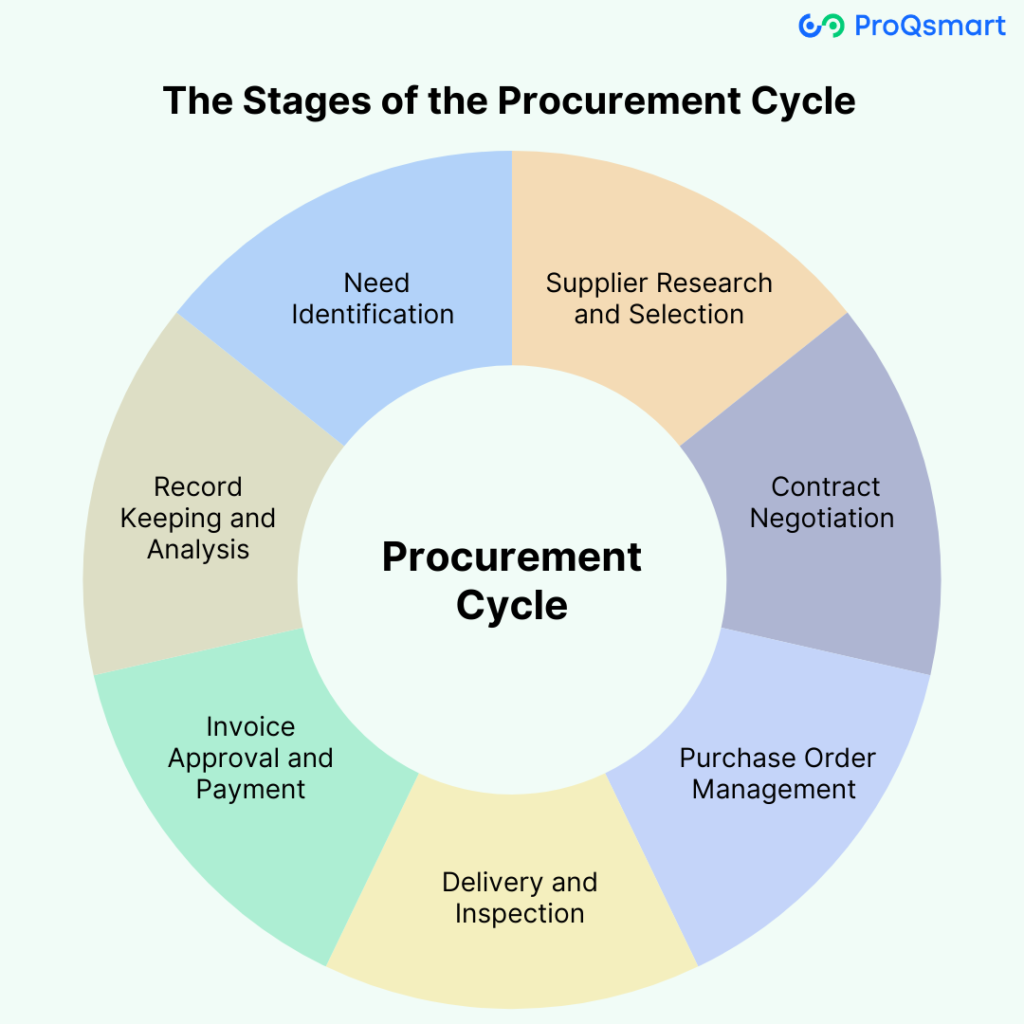The procurement cycle is a cornerstone of business operations, pivotal in streamlining purchasing processes and ensuring cost efficiency. This guide delves into the procurement cycle’s intricacies, highlighting how strategic management at each phase can improve operational efficiency and cost savings.
What is the Procurement Cycle?
The procurement cycle, or procurement process, encompasses the steps organizations take to acquire goods and services. This cycle begins with identifying needs and culminates in the management of supplier relationships. It’s a strategic process that ensures the right products are purchased at the appropriate price, delivered at the proper time, and from the right source.
The Stages of the Procurement Cycle

1. Need Identification
The cycle starts with identifying the business’s needs. This involves understanding what products or services are required, in what quantity, and when they are needed. ProQsmart can play a crucial role by analysing historical data to predict and validate the actual needs, ensuring that procurement aligns with business objectives.
2. Supplier Research and Selection
Once the needs are clear, the next step is to find suitable suppliers. This stage involves conducting market research, evaluating potential suppliers, and selecting the one that offers the best value. ProQsmart aids in this process by providing analytics and insights into supplier performance and reliability, ensuring informed decisions are made.
3. Contract Negotiation
After selecting a supplier, the next phase is negotiating terms and conditions. This includes pricing, delivery schedules, payment terms, and other contractual elements. ProQsmart can facilitate effective negotiation by offering market insights and benchmarking data, helping to secure favourable terms.
4. Purchase Order Management
With the contract in place, the procurement team issues a purchase order to the supplier. This document formalizes the transaction and includes details about the products or services, quantities, and agreed prices. ProQsmart streamlines this process by automating order creation and tracking, reducing manual errors, and saving time.
5. Delivery and Inspection
Upon receiving the goods or services, they are inspected to ensure they meet the quality and specifications agreed upon. ProQsmart’s integrated solutions can automate this process, providing real-time updates and quality checks to ensure compliance and satisfaction.
6. Invoice Approval and Payment
After inspection, the invoice is processed for payment. This step ensures that the payment terms previously negotiated are adhered to. ProQsmart can optimize this phase through automated invoice processing and payment scheduling, ensuring timely and accurate financial management.
7. Record Keeping and Analysis
The final stage involves maintaining records of all procurement activities and analysing them to assess the efficiency and effectiveness of the procurement cycle. ProQsmart’s comprehensive analytics tools offer insights into spending patterns, supplier performance, and opportunities for cost savings and process improvements.
The Importance of the Procurement Cycle
Efficient management of the procurement cycle can significantly impact a company’s bottom line. It helps reduce costs and ensures timely availability of goods and services, maintains quality standards, and builds strong supplier relationships. Furthermore, leveraging technologies like ProQsmart can enhance transparency, control, and strategic decision-making in the procurement process.
Conclusion
The procurement cycle is a complex yet vital process that requires meticulous management and continuous improvement. Integrating advanced solutions like ProQsmart can streamline procurement activities, leading to significant cost savings, improved efficiency, and a competitive advantage in the market. By understanding and effectively managing each phase of the procurement cycle, businesses can ensure their procurement processes support their overall strategic objectives and contribute to sustained success because a well-managed cycle leads to efficiency, and efficiency drives success.
FAQ
Why is the procurement cycle important for businesses?
Why is the procurement cycle important for businesses?
It ensures that a business acquires the necessary goods and services at the best possible cost, quality, and delivery time, which directly impacts the company’s operational efficiency and financial performance.
How can technology improve the procurement process?
How can technology improve the procurement process?
Technology solutions like ProQsmart can streamline procurement processes, improve accuracy in order selection, reduce manual errors, enhance supplier communication, and provide data-driven insights for better decision-making.
What are the challenges faced during the procurement cycle?
What are the challenges faced during the procurement cycle?
Common challenges include managing costs, ensuring timely delivery, maintaining quality, dealing with legal and compliance issues, and effectively managing supplier relationships.
How can businesses optimize their procurement cycle?
How can businesses optimize their procurement cycle?
By implementing strategic sourcing, investing in procurement technology, establishing strong supplier relationships, continuously analysing and improving processes, and ensuring clear communication and training within the procurement team.

Leave a Reply